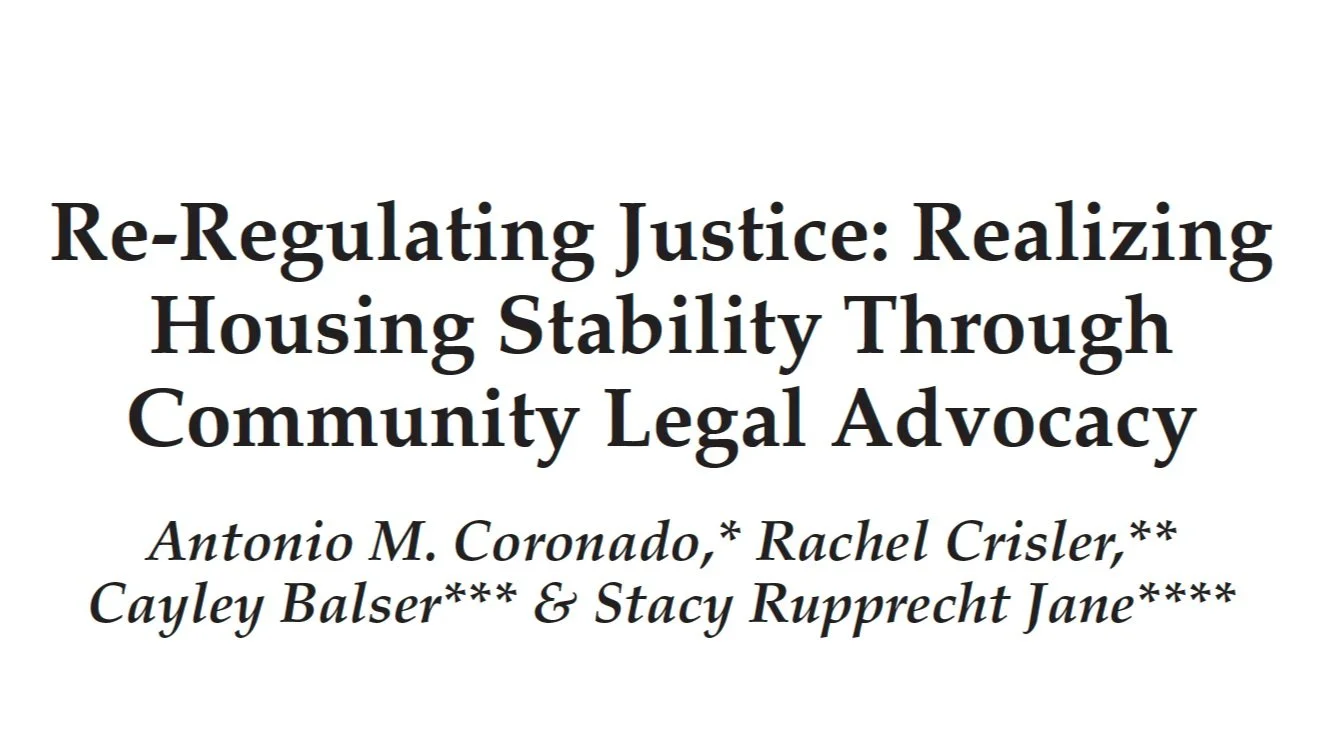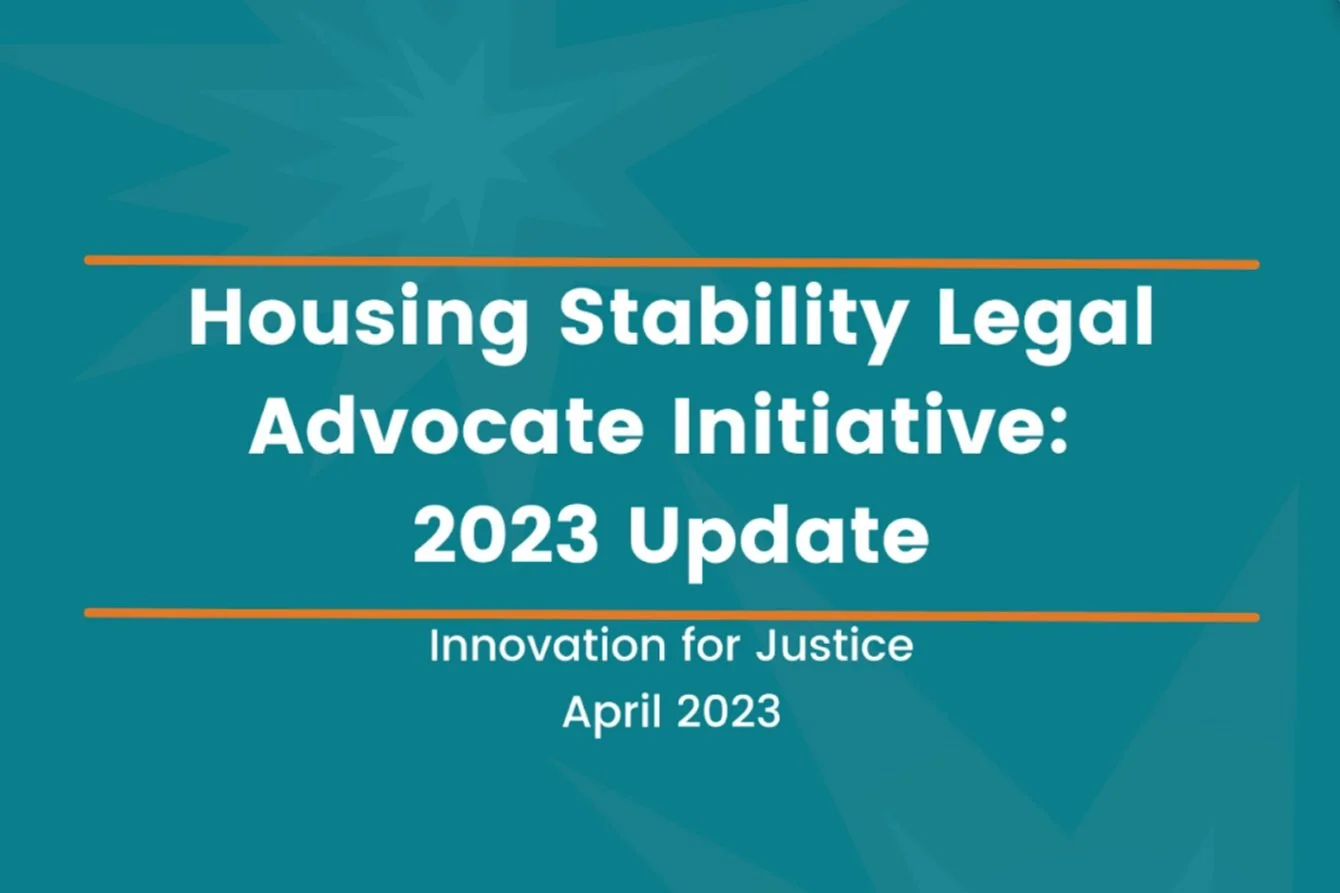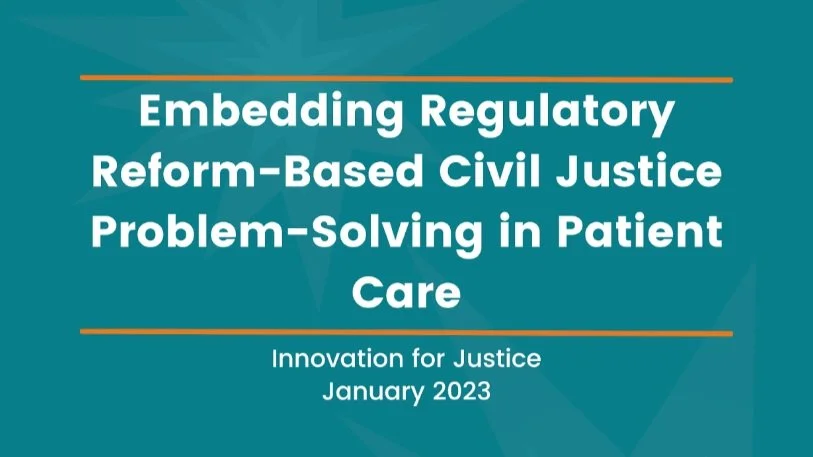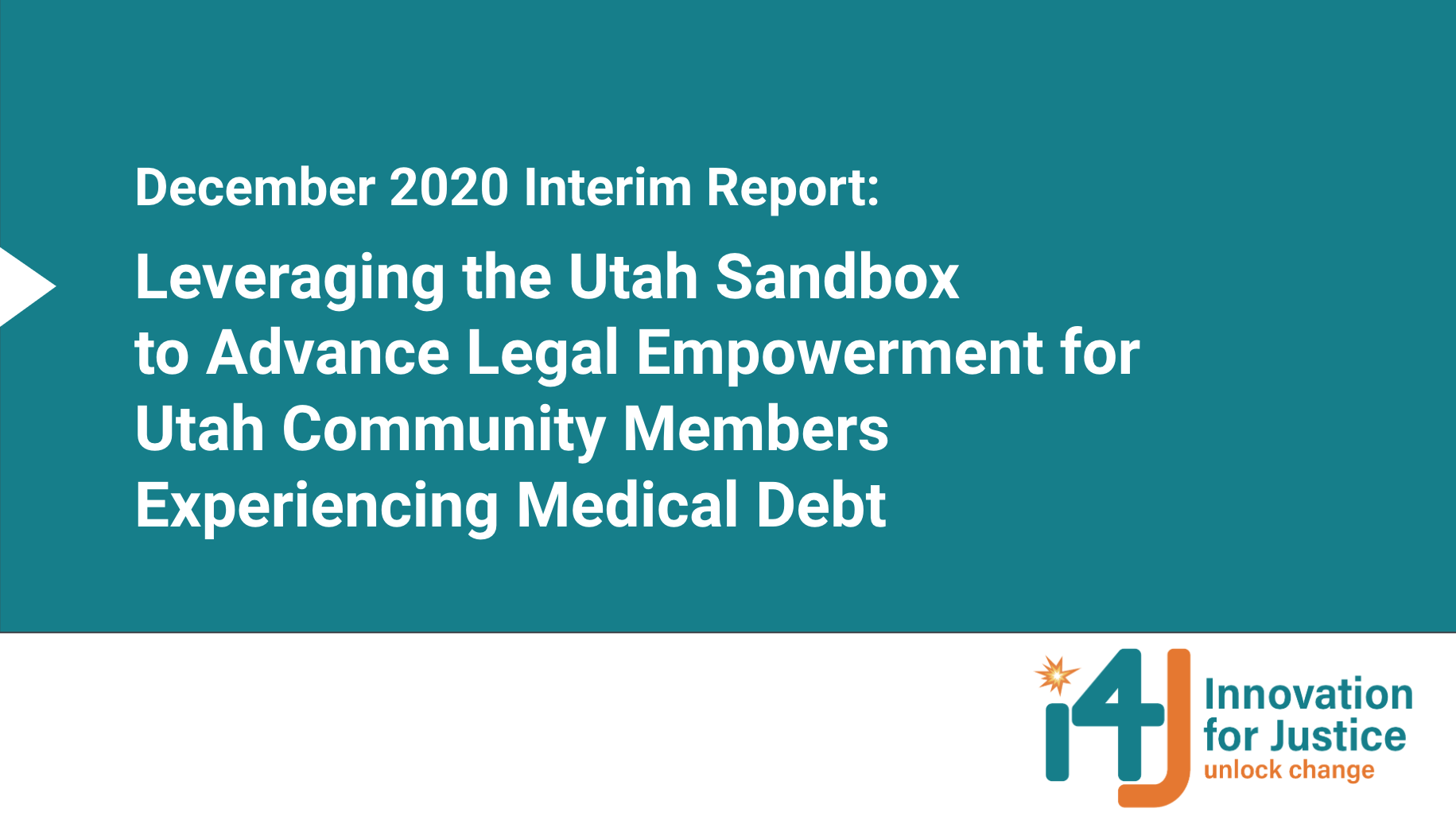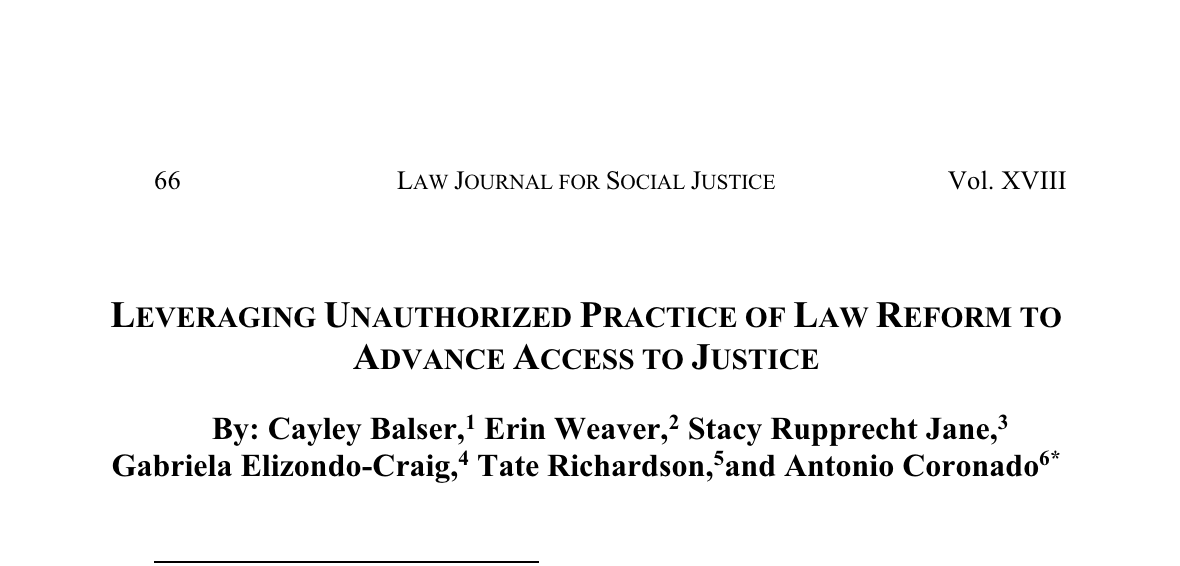Service Impact Area
Designing new legal service models.
Reform of civil legal service unauthorized practice of law (UPL) regulation presents a tipping point in the U.S. legal market, and there is limited opportunity to embed access to justice goals and models to ensure that underrepresented populations are served by these reforms. Innovation for Justice (i4J) is at the forefront of this work and is uniquely positioned as an inclusive design hub that brings the potentially divergent goals of UPL reform decision-makers, legal service providers, and systemically disinvested communities together in advancing access to justice. Using participatory action research methodology with design and systems thinking, i4J designs legal empowerment service models that provide communities with the tools and resources that they want and need to know and use the law.
In these early days of UPL reform, there is both risk and opportunity. The risk: UPL reform efforts may fall short of their potential, creating new service models that embed old legal service problems into new regulation. The opportunity: to view UPL reform from the outset as a chance to radically re-imagine the pathways for connecting people with civil justice needs — particularly those systemically disinvested and historically excluded from access to justice — to civil justice problem-solving.
Through leveraging participatory action research methods to design innovative legal service models, i4J not only includes but intentionally centers the perspectives and lived-experience of those closest to the problem in designing solutions.
What is legal empowerment?
Legal empowerment is a global, grassroots justice movement “that democratizes laws and centers people in their own fight for justice by creating opportunities for people to ‘know, use, and shape’ the laws that impact their lives.” A hallmark of legal empowerment is that it is driven by community members who are most affected by injustice, with lawyers and other professionals acting in supporting — rather than leading — roles.
In the Service Impact Area, i4J situates multiple and diverse system actors as co-researchers through implementation of participatory action research (PAR) methodology, emphasizing the learned and lived experience of those closest to the problem. In these projects, system actors contribute to the framing, scope, details, and analysis throughout projects. Implementing a trauma-informed approach to this research further creates an opportunity to develop legal service models and that embed trauma-informed practices from the outset. This prioritizes the dignity, value, and worth of individuals seeking services, regardless of their current circumstances, and mitigates the risk of replicating service models that retraumatize individuals as they seek justice.
What is unauthorized practice of law reform?
In nearly every state in the US, unauthorized practice of law restrictions prohibit anyone who is not a licensed attorney from providing legal services. UPL reform refers to the re-regulation of the practice of law, including providing legal advice, to allow people who aren’t attorneys but have specialized legal training to provide legal services, including legal advice, to community members. Many of the projects in the Service Impact Area use unauthorized practice of law reform mechanisms to allow helpers who are not lawyers to provide much needed legal advice. Four of these UPL reform projects have been implemented as i4J Community Legal Education Programs.
“The opposite of poverty is justice.”
— Bryan Stevenson
Why do legal empowerment and UPL reform matter?
In the United States, there is no right to counsel for civil cases. This means that if a person is experiencing debt collection, domestic violence, or eviction, they are not guaranteed a lawyer. The under-resourced nonprofit legal service sector lacks the capacity to serve many who seek their services: low-income Americans receive inadequate or no civil legal assistance for 93% of their civil legal problems. The historic exclusion of low-income and other systemically disinvested communities from accessing justice perpetuates poverty cycles and system-level failures. Further, Legal Service Corporation-funded legal service providers are prohibited from using LSC funds to provide services to incarcerated and undocumented community members, which contributes to the access to justice crisis for these communities.
By designing and authorizing new pathways for people other than lawyers to know and use the law, legal empowerment and UPL reform present opportunities for community members who otherwise cannot access legal help or are excluded from utilizing existing resources to receive advice and problem-solving help from trusted members of their community. The ability to successfully know and use the law plays a critical role in legal empowerment, poverty reduction, and social change.
When innovative service models leverage UPL reform, we refer to them as “community-based justice worker” models. The Institute for the Advancement of the American Legal System defines community-based justice work models as “involving training and certifying individuals working at community-based organizations to offer legal advice and services in certain case types” to low-income community members.
i4J, Legal Empowerment, and UPL reform
Since 2019, Innovation for Justice (i4J) has been at the forefront of designing legal empowerment service models that both leverage existing regulatory schemes and require UPL reform. These projects include:
Service Impact Area Projects
UPL Reform Projects Implemented by i4J
These projects have been designed and implemented by i4J with community partners. These programs have received state court authorization in their jurisdiction creating a UPL carveout for new legal service providers.
UPL Reform Project Design Blueprint
This project created a blueprint to help healthcare systems design their own community-based justice worker programs. This program is not currently implemented by i4J and instead acts as a design example for others wishing to pursue UPL reform and program development.
Legal Empowerment Design Project
This project does not require UPL reform for implementation. Instead, this project design focuses on interventions that can be implemented in the existing regulatory structure.
i4J’s work in the space is unique because it emphasizes the importance and inclusion of four diverse system actors in design work:
Community members who are in a position to leverage legal empowerment and UPL reform opportunities;
Community-members who would benefit from access to legal knowledge and services authorized through UPL reform mechanisms;
UPL reform decision-makers; and
The design hub: an inclusive research and design entity who can gather legal need information from the first three system actors and help synthesize the potentially divergent goals of these 3 system actors into effective new legal service models.
The first three system actors interface at various opportunity spaces in the system of civil justice problem-solving; the design hub brings these system actors to the table to work together to create systems and services that are more equitable and informed by multiple perspectives. This includes and emphasizes the perspectives, lived, and learned experiences of community members historically and actively excluded from access to justice decision-making conversations.
While most of the projects in i4J’s Service Impact Area focus on UPL-reform-based interventions, there is also opportunity for legal service innovation within the existing regulatory structure. This includes projects that focus on engaging diverse system actors in designing new programs and designing service models that get closer to the existing regulatory line.
Interested in designing your own community-based justice work or legal empowerment service model?
Start with this seven question framework:
What are the unmet community needs that the service model would be addressing?
Who in the community is trusted and positioned to meet those needs?
Will the service model require UPL reform?
Who will do the training and mentoring?
Who will credential the justice worker?
Will this service model need insurance?
What will be the scope of service?
For examples of how i4J and other programs have answered these questions, visit this IAALS expert opinion authored by i4J’s Cayley Balser and Stacy Rupprecht Jane, The Diverse Landscape of Community-Based Justice Workers.
Service Impact Area Publications and Reports
i4J's Service Impact Area engages in robust participatory action research in the design of new legal service models. Findings and recommendations from service model design are reported out to the community and in the access to justice research space through reports and publications for each project. To learn more, see our reports and publications below.


